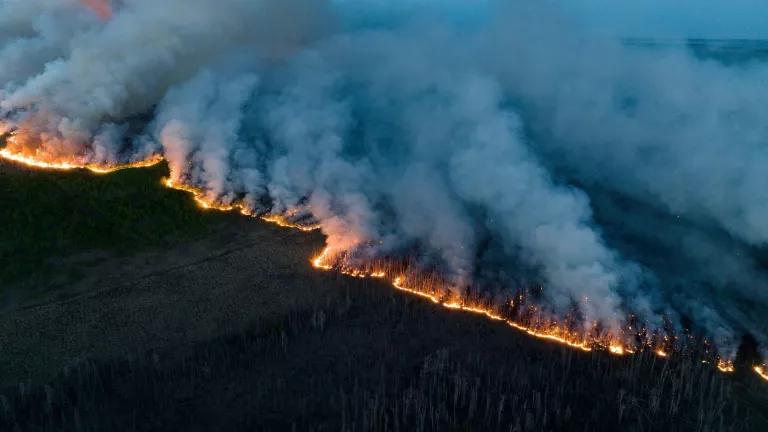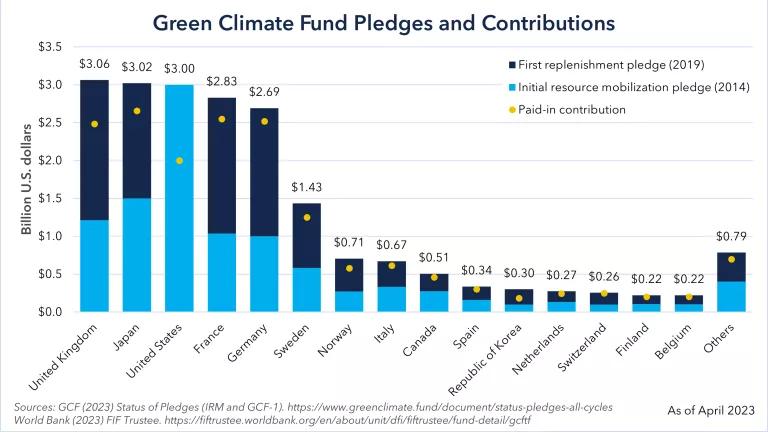It Is Past Time to Upgrade Our Power Grid for New Challenges
Hurricanes, severe cold spells, ice storms, and other disasters have overwhelmed power systems, shutting down power plants that depend on it. Now is the time for action.

Part of NRDC’s year-end series reviewing 2022 climate & clean energy developments
For more than a decade and likely longer, regional grid operators across the U.S. have acknowledged the risks posed by a cascade of extreme weather events caused by climate change. Hurricanes, severe cold spells, ice storms, and other disasters have overwhelmed power systems, shutting down power plants that depend on it. The result is billions of dollars in damages and, in some cases, the tragic loss of life.
With so much riding on the reliable delivery of power, grid managers and utilities should be well on the way to implementing solutions to enhance reliability and safeguard homes, businesses, and livelihoods. Frustratingly, they are not. In fact, for some, these challenges are causing them to look backwards at last century’s solutions—rooted mainly in fossil power—rather than forward.
With few exceptions, Regional Transmission Organizations (RTOs) have been slow to embrace proven, practical, cost-effective measures to make the grid nimbler and more resilient. These include taking an honest look at the risks of our uncertain gas supply, clearing the massive backlog of clean energy resources waiting to connect to the grid, and putting a fair price on demand response and energy efficiency, solutions that lower energy use.
In the coming year and beyond, the Sustainable FERC Project will continue to press for solutions that make our grid more resilient, lower costs, and protect the environment.
Where things stand
The North American Electric Reliability Corporation (NERC), the organization tasked with assuring the reliability of North America’s grid, issued a sobering assessment last month. It stated that large portions of the bulk power system are at risk of supply shortages during extreme winter weather conditions. NERC’s findings followed the assessment of the Federal Energy Regulatory Commission (FERC), the top U. S. energy regulator, which in October said that certain regions of the country were unprepared for crippling weather events like the 2011 cold weather outages in the Southwest, the 2014 polar vortex, or Winter Storm Uri, which struck Texas in 2021.
Our power grid defied record-breaking heat waves and doomsday warnings to survive last summer without major interruptions, and the National Oceanic and Atmospheric Administration (NOAA) has forecast above-average winter temperatures for most of the U.S. this year. But luck doesn't last forever. We need a grid that is ready for whatever challenges come its way.
Those challenges are coming, and they should be no surprise. For years, the world’s top climate scientists have warned that climate change will cause more frequent and extreme weather events. Over the last few years, we’ve watched those grim predictions come true. Whether it’s extended frigid temperatures, wildfires in New Mexico, record heat waves in California and Texas, or flooding in St. Louis, Dallas, and Kentucky, it’s now clear that climate change is posing risks to all of us.
NERC’s RTO reliability breakdown
- Texas ERCOT
Overreliance on natural gas continues to threaten reliability. Gas disruptions caused by freezing were the main cause of the disastrous power outages in Texas during unusually cold blasts in 2011 and 2021. While ERCOT has made some progress on ensuring gas-fired power plants are ready for winter, gas-friendly Texas has not done the same for its fuel supply. The potential for outages caused by freezing wells, pumps, or pipelines remains during harsh winter conditions. - Midcontinent ISO (MISO)
Since the 2021/2022 winter, reserve margins in MISO have fallen by more than 5%. An extreme cold-weather event that extends deep into MISO could lead to generator outages from inadequate weatherization at southern units and unavailability of fuel for gas-fired generators. Constraints on the rail system have created challenges to coals supply. - ISO New England
Gas pipeline capacity could be constrained should cold temperatures cause peak demand for both electricity generation and home heating. Unreliable gas supply could lead to power plant outages and consumer power cuts during extreme weather.
Overreliance on fossil fuels contributes to all of these regional grid risks, a fact that makes NERC’s support for keeping gas and coal plants open to address the problem increasingly frustrating. This is exactly backwards. Adding insult to injury, more than 1 terawatt of power—mostly renewables and storage—is waiting to get built, but this has been held back for years by grid operator and utility bureaucracies.
The path forward
The Sustainable FERC Project and many others are supporting two current efforts from FERC that would put the utility industry in a better position to withstand extreme weather and help prevent blackouts and other emergencies.
First, efforts are underway to upgrade our decades-old power grid and to confront the thorny issues of transmission planning and interconnection, which in the U.S. have failed to accommodate a generational shift to renewable power.
If we cannot move clean energy from remote areas where it is produced to big cities and towns where it’s needed—in some cases, across multiple transmission regions—keeping the lights on and air conditioners running will become increasingly difficult. FERC is going in the right direction here, but it must go further by mandating long-term regional planning with specific criteria and highlighting the benefits of transmission to customers.
California’s access to a giant, regional grid helped the state survive a record heat wave this past summer. The sprawling western grid, which includes two Canadian provinces, creates geographic diversity that allows grid operators to tap generators experiencing different weather systems, essentially smoothing out temperature extremes and fluctuations. It also allows access to geographically diverse power sources like hydropower, wind, and solar.
FERC recently held a workshop on establishing an interregional transmission transfer requirement. Interregional transmission is essential to allowing the grid to access geographic diversity that helps grid operators tap generators experiencing different weather systems, essentially smoothing out temperature extremes and fluctuations. FERC must move quickly to propose rules on interregional transmission planning.
FERC’s other proposal would require transmission planners to study extreme heat and cold events and to develop plans to address potential impacts. It would also require NERC to develop extreme weather reliability standards for transmission planners.
Every challenge an opportunity
FERC should recognize that extreme weather is occurring more frequently and require transmission planners to plan for the failure of any generation resource due to extreme weather because, as we know, coal piles freeze, gas lines stop flowing, and nuclear plants may need to shut down when critical systems are lost. Any reliability standard must fairly acknowledge the uncertainties of all generation sources, not just solar and wind power.
We have a historic opportunity to build a more nimble, reliable and resilient grid. This does not mean propping up the dirty power sources that have caused the climate crisis. It does mean implementing real solutions: technologies that increase transmission capacity, battery storage, energy efficiency, and demand response. Grid reliability is often a life-or-death proposition.
We need to put in place a truly 21st century power grid to ensure the grid delivers. The solutions are right at our fingertips. It’s time to use them.



